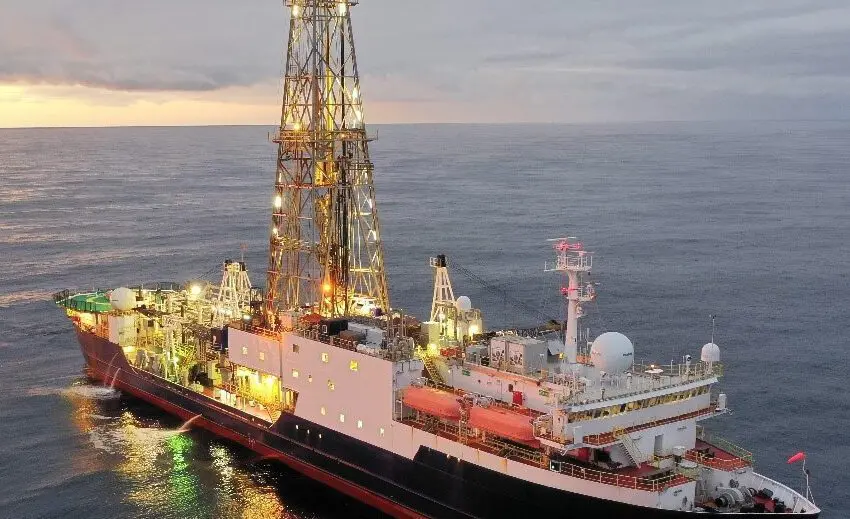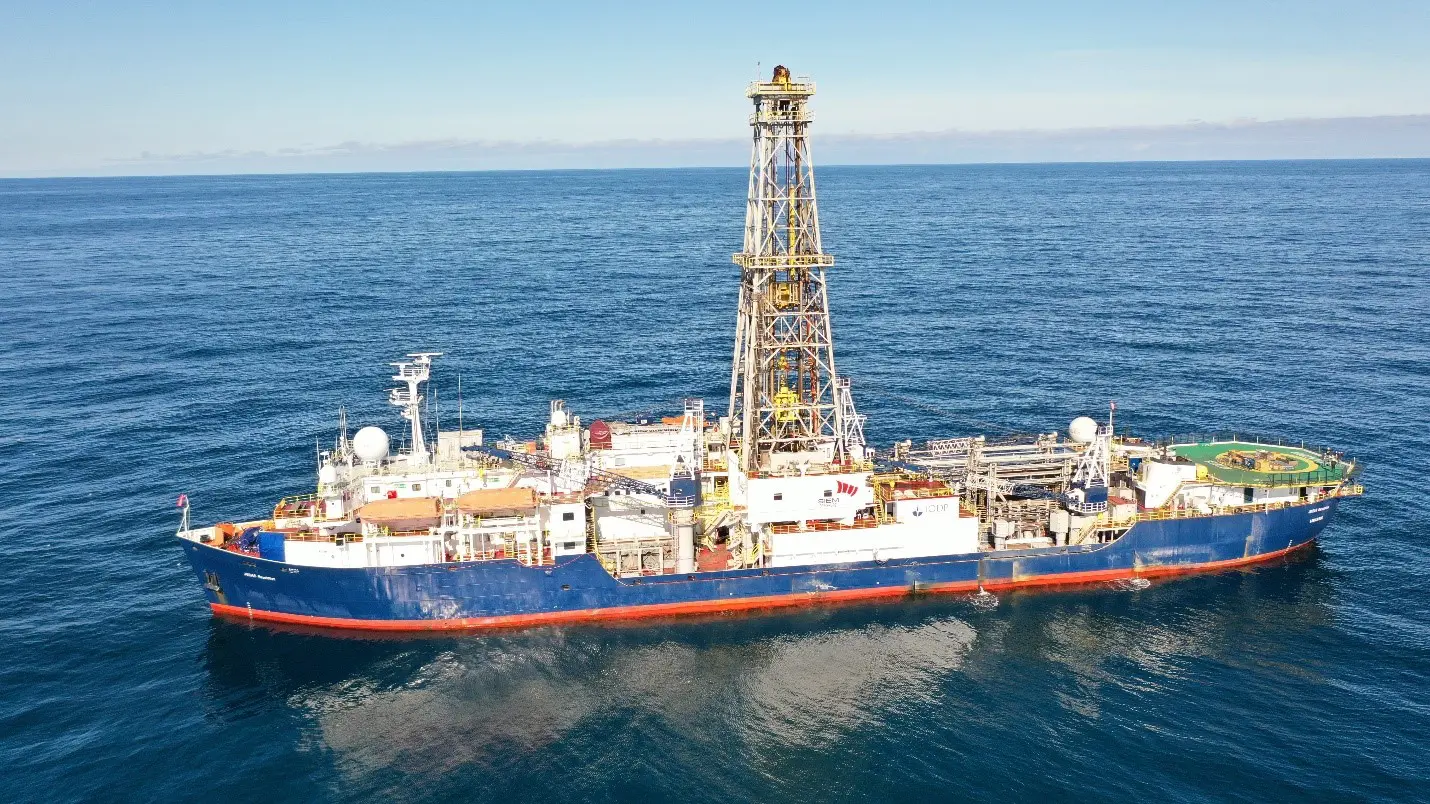Q & A @ C

The massive drilling vessel Joides Resolution out at sea. Photo: Peter Betlem/UNIS
Top image: The massive ocean drilling scientific vessel JOIDES Resolution out at sea. Photo: Peter Betlem/UNIS
Earlier this autumn, PhD-candidate Peter Betlem spent 2 months on board the JOIDES Resolution (JR), an ocean drilling scientific vessel. We held an informal Q&A-session, and here are the answers to life on board one of the world’s most advanced research ships.
15 November 2021
Text: Peter Betlem and Maria Philippa Rossi
Q: What’s life on board like?
A: That slightly depends on which shift you are on. We run three different 12-hour shift onboard; midnight to noon, six (am) to six (pm), and noon to midnight. You usually wake up about an hour before the start of the shift and pre-shift breakfast, and some even earlier to go to the gym. Then we do our respective analytical tasks, have cookies and cake at every 3rd and 9th hour, and lunch every 6th, and dinner after the end of the 12-hour shift. However, we often show up half an hour early to discuss the latest with our counterparts, and stay several hours afterwards to work up the latest results and write down the necessary reports. A day quickly runs up to 14-16 working hours, though there’s also time to watch whales and dolphins, sunsets and sunrises, and the northern lights. No weekends, though!
Q: Do you have your own cabin?
A: Yes, many of us have our own cabins, which was also a Covid-19-precaution. However, day- and nightshift-scientists share the same room, and the room is yours for 12 hours at a time. That is the way I am sharing a room with one of the scientists on the day shift, at least.
Q: What kind of people are needed?
A: Right now, we have paleomagnetists, structural geologists, physical property and downhole measurement specialists, micropalaeontologists, geochemists, sedimentologists, petrologists, and Core-Log Integrators on board to operate all the different labs, with many specialists working in labs other than their specialties. Mission specific needs change from expedition to expedition, and so do the analytical needs for each site – in other words, flexibility may be requirement #1.

Q: What are the opportunities for young people, I.e., undergraduates?
A: There are plenty of chances for undergraduates to join on various research cruises, as for example offered by some of the UNIS courses. IODP, however, usually only allows PhD students and higher to join. That is not because undergraduates would not be qualified for the work on board. Rather, it takes a good year of planning before the expedition, and several years of work after the expedition to go through all the collected data. It is quite an investment, too, meaning an expedition scientist needs to have a contract that covers at least most of the required time.
Q: It has been my biggest dream ever! How to reach there?
A: With that motivation, it is as simple as keeping an eye out for expedition calls at Expeditions Schedule | Expeditions | IODP and IODP JRSO • JOIDES Resolution Expedition Schedule (tamu.edu) and apply. There are often several calls open at the same time, with each expedition having distinct objectives, topics, and scientist requirements. Good luck!
Q: How to become a boring engineer?
A: Engineers are not boring, what do you mean?
Q: No, no, how to become a boring engineer?
A: Ah! That’s easy – one simply swaps out the geologist’s hammer for a drill (rig).

Q: I have a Watch Keeping Certificate, is it possible to work as a scientist & crew?
A: As a scientist, of course! Most of us do not even have such a certificate. Crew signups, though, need all sorts of certificates and trainings.
Q: Have you seen many other ships around?
A: Yes, to our surprise there were quite a few fishing vessels around our position for at least the first half of the expedition; have not seen that many since the storm hit.
Q: What is the research about?
A: The expedition aims to understand how the great volcanic province of the Northeast Atlantic was formed, how this volcanism may have led to global warming 56 million years ago, and to see whether the basaltic sequences have carbon sequestration potential that can help address the current climatic challenges.
Q: How is data and core material being handled?
A: As soon as the core comes on deck, a dedicated team of laboratory technicians heads out to the rig floor and brings it to the catwalk. That is where the full-length core gets cut into manageable pieces, gets measured and the recovery is calculated. The sections then acclimatize for four hours before being measured on the automated tracks for physical properties, and are split into working and archive halves. The working halves are then analysed and cut to pieces for further analyses whilst the archive halves are described. All generated data (including where the cores are cut, pieces are extracted, data generated) are all stored into a centralized database.
Q: How many people can stay on the ship permanently?
A: No one stays onboard permanently; but at a given time the vessel can house up to a hundred or so crew (including science party). Some decide to stay on for multiple 2-month expeditions in a row.
Q: How many scientists are on board the JR? Where are they from?
A: We currently have 19 scientists from a dozen or so countries on board, including Norway (and Svalbard), USA, India, UK, the Netherlands, Germany, France, Japan, Ireland, and China.
Q: How many technicians?
A: About 20 Operations and Technical staff, though they are very much part of the core team!
Q: What is your favourite part of doing research on board?
A: Being onboard as shipboard scientists allows you to contribute to the entire data acquisition and analysis chain, that in turn allows you to understand the strengths and weaknesses of a particular data set much better. That, and learning from the best experts from around the world is a key experience. Also, the sunrises are spectacular!
Q: Do you get sea sick?
A: Everyone does from time to time. (P.s., don’t ever say you don’t get sea sick; you’ll probably be the first one to go down)
Q: How do you cope with sea sickness?
There is a few of us who have not been feeling so well for the entire expedition. Most, however, find their sea legs after a couple of days and no longer feel the big swells, just feeling sleepy on the rougher days. However, once it is there, it is there and there is not much you can do about it other than simply sleeping it off and hoping tomorrow is a better day.

Q: Do you get sea sick even if you are experienced?
A: Of course – those telling you otherwise are usually the first to fall victim.
Q: What is for dinner today?
A: We have had pancakes for breakfast, chicken for lunch, and Mexican for dinner. But the ice cream machine and daily selection of cakes is best!
Q: How is the food on such a long ride?
A: Those on the day shifts tend to get more fancy BBQs on deck, with warmed-up or kitchen-grilled “leftovers” for the nightshift. The nightshift, however, has the best sunrises and fresh pastries/cake, as the baker is on our shift.
Q: When did you have your last beer?
A: Well, I am not the biggest fan of beer, so that must have been quite a while ago. Last time I went to the pub is a better question; it must have been more than two months ago, given the two-week pre-departure quarantine and hotel isolation. Let us say middle of July?
Q: Is there a sauna?
A: Nope, not even a hot tub, sadly!
Want to learn more about Expedition 396 and JOIDES Resolution? Check out this interview with Peter during his stay on board.